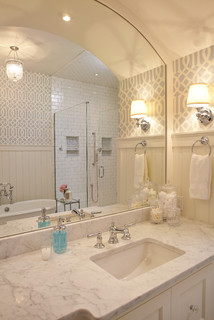How to Light Your Bathroom Right
 Wednesday, October 9, 2013 at 1:27PM
Wednesday, October 9, 2013 at 1:27PM Article By: Tiffany Carboni
The bathroom is one of the only rooms in a multibodied household where we’re expected and encouraged to lock ourselves inside. With that kind of permission, it makes sense to use this private space as a luxurious sanctuary. Make the most of your haven by giving it the proper lighting.
I spoke with two lighting experts about how best to transform a bathroom into a relaxing, functional refuge with light. Here's their advice.
The four types of light needed for the best bathroom atmosphere are task, accent, decorative and sparkle.
Task Lighting
This is the light by which you can best see yourself. “Proper task lighting at the mirror is important,” says lighting designer Randall Whitehead.
He recommends using a pair of sconces mounted at eye level on either side of the mirror to provide shadowless illumination. This creates the best scenario for makeup application, shaving, tooth care and so on.
Tip: Avoid adding a light above the mirror. That includes recessed lighting in the ceiling. “That would throw a strong light onto your forehead and cast deep shadows below your eyes, nose and chin,” Whitehead says. “Not only is this light ineffective for shaving or applying makeup, it can visually age you by 10 years. People should look their best when they look at their reflection.”
Proper lighting in the bathroom will make you feel better about yourself and promote confidence throughout your day.
Wattage for task lighting. “In the master or guest bathrooms, use fixtures that provide 75 to 100 watts' worth of illumination," Whitehead recommends. “You can get these wattage equivalents in a 24- to 26-watt compact fluorescent or 20- to 25-watt LED.”
Tip: Putting task lighting on a dimmer will allow your eyes to adjust first thing in the morning; it will also help you wind down at night.
Task lighting wattage in the powder room. Task lights in powder rooms can have much less wattage (think 45-watt range), as this is not a space where anyone will be performing the morning ritual. Lower wattage provides a softer, relaxing ambience for guests.
Find a color temperature that makes the room feel inviting and illuminates guests in the most attractive way.
Accent Lighting
If you enjoy art in your bathroom, accent lighting will show it off best. Recessed directional lights provide focused illumination for each piece of art — or, in this case, for an alcove dedicated to a sculptural bouquet of flowers.
Decorative Lighting
This adds visual sparkle. Whitehead advises using a single pendant in a square-shaped bathroom for just the right touch.
In a grand rectangular bathroom, he recommends using two to three fixtures installed along the ceiling plane for adequate illumination.
Candles also offer wonderful sparkle and set a distinctly relaxing, romantic tone. Just make sure you keep them well away from any flammable objects, such as towels and hair, and never leave them unattended.
Ambient Light
This acts as fill light. “In bathrooms with taller ceilings, a cove or cantilever details, ambient lighting fixtures can be installed along the perimeter of the space," Whitehead says. "Architectural details such as these can hide the fixture and create indirect lighting.”
A pendant fixture with a translucent shade can be a source of both decorative and ambient light.
Putting It All Together
Interior designer Katie Anderson transformed the dark bathroom shown here in many ways, but one of the most significant — and most universally useful — was bringing in light.
“Before, there weren't enough light sources or appropriate fixtures to layer light," Anderson says. "Moreover, there wasn’t any natural light."
Her mission: devise a lighting plan that would illuminate the shower, tub and sink areas evenly. Here's what she did.
AFTER: Sconces on large mirrors at the sink vanities now offer functional task lighting. Recessed cans on dimmers provide ambient light for whatever mood is desired. Dimmers are especially useful in the tub area, where relaxation and romance are priorities. Wall sconces offer additional ambient and decorative light.
Large mirrors, both at the vanity and over the tub, effectively reflect all of these layered light sources for the best effect.
Whitehead suggests putting the fan and lighting on separate switches. “I don't want the fan to go on automatically every time I go in to wash my hands,” he says. Putting each light source — or a logical combination of light sources — on different switches allows you to choose what you want lit when.
Tip: If you use recessed cans over the sink, make sure they are on a different switch than your task lighting, as Anderson did.

































